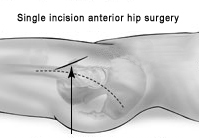Anterior Approach Hip Replacement

Anterior Hip Replacement Advantages:
- Less invasive and muscle sparing
- Decreased dislocation potential
- Live x-ray can enhance accuracy in placement of components
Less Invasive and Muscle Sparing
The anterior approach is a single incision, muscle sparing total hip replacement approach. With the anterior approach, your surgeon can work between your muscles and tissues without detaching them from the hip or thigh bones.
Decreased Dislocation Potential
Generally speaking, an anterior approach is inherently more stable than a posterior approach. A recent study in the Journal of Bone and Joint Surgery reported that the most common reason for revision (redo) of a hip replacement is for dislocation (where the ball pops out of the socket requiring a physician to put it back in place). The majority of dislocations are in a posterior direction. Although experienced hip surgeons may have a very low dislocation rate with a posterior approach, an anterior approach avoids violating the posterior structures altogether. This potentially allows for a lower dislocation risk. In fact, our patients are not given any “hip precautions” (restrictions of certain positions) following an anterior approach allowing for a more straightforward and potentially faster recovery.
Live Xray (Flouroscopy)
The anterior technique allows for use of a live mobile x-ray (fluoroscope) during the procedure. This device enables your surgeon to not only visualize the components by direct vision, but also visualize the hip replacement with an x-ray to ensure that appropriate sizing and position of all components has been achieved.
The fluoroscope also allows your surgeon to compare one hip to the other with increased ability to measure for correct limb lengths. One of the most common problems we encounter in hip replacement is limb length inequality. Although not foolproof, an intraoperative live xray comparison before the surgery is completed can enhance the accuracy of this measurement.
Want to make an appointment?
Complete our “Request an Appointment” in our Chat Box on this page. We will contact you about choosing the date and time for your appointment.
